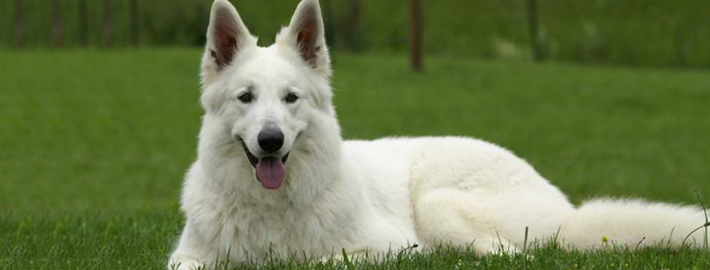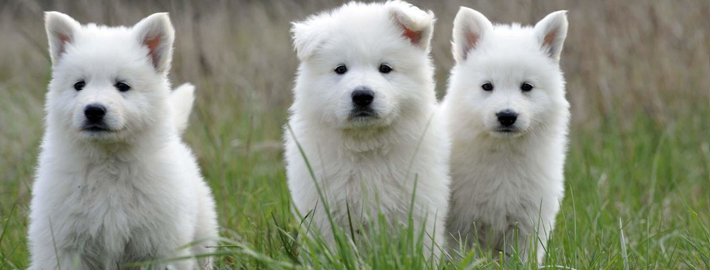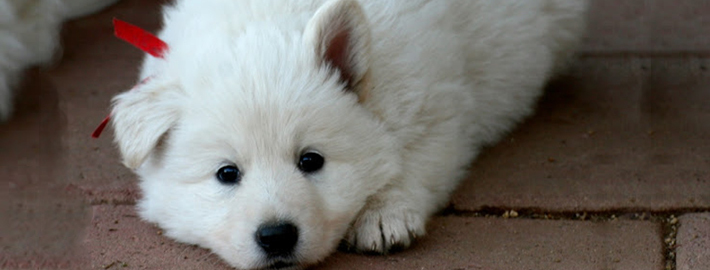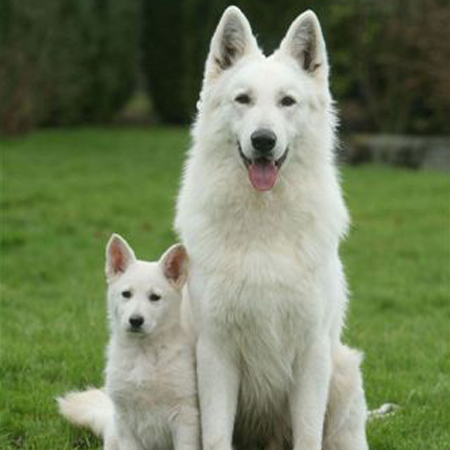What makes the Berger Blanc Suisse Unique?
Berger Blanc Suisse is a medium-sized, well-balanced and muscular dog. It has become one of the most versatile working dogs serving mankind due to its high degree of intelligence and sense of loyalty. Commonly known as Snowy Shepherd, the dog is of the same origin as the White Shepherd Dog and German Shepherd Dog. The snow white color makes the dog distinctive and easily recognizable. The Berger Blanc Suisse is gentle and mellow but he is very willing and capable to protect his family. Because of their intense loyalty and love of children, Berger Blanc Suisse make outstanding family dogs.
Page Contents
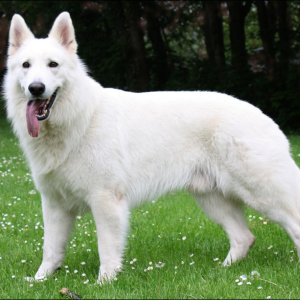
Is the Berger Blanc Suisse Right For You?
Berger Blanc Suisse are highly intelligent, playful, loyal, social, and gentle dogs. They are curious and very easy to train. They get along well with other dogs and pets. Because they are very athletic and like to work, they are ideally suited for all kinds of sports like herding, obedience, agility, tracking & protection.
Berger Blanc Suisse can compete in dog agility trials, obedience, showmanship, flyball, tracking, and herding events. The Berger Blanc Suisse gets along well with other dogs and is also excellent for training, such as agility, search and rescue, and obedience. They are even seen doing protection work, though they are not used for that very often and are not always up for the job.
In 5 Words
- Gentle
- Intelligent
- Learns Easily
- Fearful
- Obedient
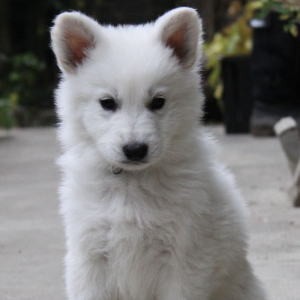
Characteristics
Learn About the Berger Blanc Suisse
Description
General Description
The first impression of a White Shepherd, White Swiss Shepherd or White German Shepherd Dog is that of a strong, agile, well-muscled animal, alert, full of life, keen, intelligent, and composed. It is well balanced, with harmonious development of forequarter and hindquarter. The dog is longer than tall, deep-bodied, and presents an outline of smooth curves rather than angles. It looks substantial and not spindly, giving the impression, both at rest and in motion, of muscular fitness and nimbleness without any look of clumsiness or soft living. The ideal dog is stamped with a look of quality and nobility–difficult to define, but unmistakable when present. Secondary sex characteristics are strongly marked, and every animal gives a definite impression of masculinity or femininity, according to its sex.
Coat
The ideal dog has a weather-resistant double coat of medium length. The outer coat should be as dense as possible, hair straight, harsh and lying close to the body. The undercoat is short, thick and fine in texture. A slightly wavy outer coat, often of wiry texture, is permissible. The head and ears are covered with a smooth, somewhat softer and shorter hair while the hair covering the legs and paws is more harsh-textured. At the neck, the coat is slightly longer and heavier. A male may carry a thicker ruff than a female. The back of the legs has a slightly longer covering of hair and there is considerably more hair on the breeches and the underside of the tail. For the White Shepherd specialization, both somewhat shorter and longer coats are acceptable.
Color
The coat color is white as defined by the breed’s name and the ideal is pure white. Any degree of shading that ranges from a very pale cream to a light biscuit tan are not preferred, and is considered a fault for the White German Shepherd and White Shepherd specialization.
Skin Pigment – Skin color on the body is pink to dark gray/black, with gray/black being preferred, and the skin of the belly being the darker area. Pink skin is frequently seen, and though not a disqualification, is less desirable. The nose, lips and eye rims should be fully pigmented and black in color. The more dark in color of the nails, the better, although white nails do not disqualify a dog. The pads of the feet should be black. Very slight snow nose coloration is acceptable but is not preferred. Deficiency of pigment is objectionable and dogs exhibiting faded, pinkish or spotty pigmentation on nose, eye rims or lips are a serious faulted. The total lack of pigment in the above named areas, indicating possible albinism or definite albinism with blue or pink eyes, are a disqualifying fault for both white coat German Shepherds and the White Shepherd specialization.
Head
The head is noble, cleanly chiseled, strong without coarseness, but above all, not fine, and in proportion to the body. The head of the male is distinctly masculine, and that of the bitch, distinctly feminine. The muzzle is long and strong, with lips firmly fitted, and its top line is parallel to the top line of the skull. Seen from the front, the forehead is only moderately arched, and the skull slopes into the long, wedge-shaped muzzle without abrupt stop. Jaws are strongly developed.
Ears are moderately pointed, in proportion to the skull, open toward the front, and carried erect when at attention, the ideal carriage being one in which the center lines of the ears, viewed from the front, are parallel to each other and perpendicular to the ground. A dog with cropped or hanging ears must be disqualified.
Eyes are of medium size, almond shaped, set a little obliquely and not protruding. The color is as dark as possible. The expression is keen, intelligent, and composed.
Teeth number 42 with 20 upper and 22 lower. Teeth are strongly developed and meet in a scissors bite in which part of the inner surface of the upper incisors meet and engage part of the outer surface of the lower incisors. An overshot jaw or a level bite is undesirable. An undershot jaw or a level bite is an undesirable fault. Complete dentition is to be preferred. Any missing teeth other than first premolars is a serious fault.
Neck
The neck is strong and muscular, clean-cut and relatively long, proportionate in size to the head, and without loose folds of skin. When the dog is at attention or excited, the head is raised and the neck carried high; otherwise, typical carriage of the head is forward rather than up, but a little higher than the top of the shoulders, particularly in motion.
Body
The whole structure of the body gives an impression of depth and solidity without bulkiness.
Chest Commences at the posternum and is well filled and carried well down between the legs. It is deep and capacious, never shallow, with ample room for lungs and heart, carried well forward, with the posternum showing ahead of the shoulder in profile.
Ribs are well sprung and long, neither barrel-shaped nor too flat, and carried down to a sternum which reaches to the elbows. Correct ribbing allows the elbows to move back freely when the dog is at a trot. Too round causes interference and throws the elbows out; too flat or short causes pinched elbows. Ribbing is carried well back so that the loin is relatively short.
Abdomen is firmly held and not paunchy. The bottom line is only moderately tucked up in the loin.
Top Line of the back is straight and very strongly developed without sag or roach. The desirable long proportion is not derived from a long back, but from overall length in relation to height, which is achieved by a length of forequarter, withers and hindquarter, as viewed from the side. The croup is long and has only a very minor and gradual slope when in the show stance.
Withers are higher than, and sloping into, a level back.
Loin viewed from the top, broad and strong. Undue length between the last rib and the thigh, when viewed from the side, is undesirable.
Forequarters – The shoulder blades are long and obliquely angled, laid on flat and not placed forward. The upper arm joins the shoulder blade at about a right angle. Both the upper arm and the shoulder blade are well muscled. The forelegs, viewed from all sides, are straight and the bone oval rather than round. The pasterns are strong and springy and at an angle of approximately a 24 degrees from the vertical.
Hindquarters – The whole assembly of the thigh, viewed from the side, is brood, with both upper and lower thigh well-muscled, forming as nearly as possible a right angle. The upper thigh bone parallels the shoulder blade while the lower thigh bone parallels the upper arm. The metatarsus is short, strong, tightly articulated and no dew claws should be present.
Feet – The feet are short, compact, with toes well arched, pads thick and firm, nails short and preferably dark. Dewclaws on the forelegs may be removed, but are normally left on. Dewclaws, if any, should be removed from the hind legs.
Tail – The tail is bushy, with the last vertebra extended at least to the hock joint. It is set smoothly into the croup and low rather than high. At rest, the tail hangs in a slight curve like a saber. A slight hook–sometimes carried to one side is faulty only to the extent that it mars general appearance. When the dog is excited or in motion, the curve may be accentuated and the tail raised, but it should never curl forward beyond the vertical line. Tails too short, or with clumpy ends due to ankylosis, are serious faults.
Short History of the Berger Blanc Suisse
On 3 April 1899, the first German Shepherd Dog as we know the breed today is officially registered. This dog was a completely white coated male, and was used by cattle and sheep herders at that time, they used this white dog to distinguish them from wolves.
After the creation of the German Shepherd breed, all colours were accepted. It was in the first decades of the 20th century, when the white exemplaries were excluded, therefore persecuted and almost wiped out in Europe.
The first White Shepherd club was founded in the 1970s in America. Meanwhile the breed appeared again in Europe. At first in Switzerland and Denmark, Germany came next. Slowly, the European cynological societies began to open their stud books to the White Shepherd.
The dog Lobo, born in 1966, was the first White Shepherd to be registered in Europe, specifically in Switzerland. The breed was recognized in Switzerland 1991, the Netherlands followed in 1992. The Czech Republic, Austria and Denmark also recognized the breed.
Temperament
He is gentle, very intelligent and learns easily. He is loyal to his family and may be wary around strangers, but should never show shy or fearful behavior. Some people think the Arctic Wolf was mixed with the breed to create his caution, but this is not the case. The Berger Blanc Suisse gets along well with other dogs and is also excellent for training, such as agility, search and rescue, and obedience. They are even seen doing protection work, though they are not used for that very often and are not always up for the job. They are also used as assistance dogs and occasionally for mushing.
The character of the Berger Blanc Suisse is gentler and mellower than that of the German Shepherd Dog, but when it comes down to it he is very much capable of and will protect his family.
Caring for Your Berger Blanc Suisse
Grooming & Bathing
A good brushing performed daily will keep hair shed in the home to a minimum. Wet bathing should be limited to only once or twice per year in order to avoid depletion of skin oil. The White Swiss Shepherd Dog is a constant moderate shedder as well as a seasonally heavy shedder.
Exercise & Training
Berger Blanc Suisse can compete in dog agility trials, obedience, showmanship, flyball, tracking, and herding events. Herding instincts and trainability can be measured at noncompetitive herding tests. Berger Blanc Suisse exhibiting basic herding instincts can be trained to compete in herding trials.

